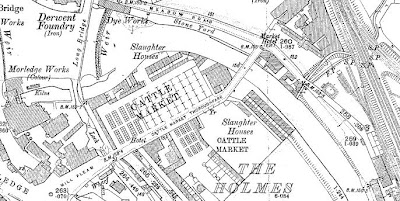I never thought it was odd that just a short walk from Hope Street there was a cattle market despite it being so close to iron foundries, dye works, and timber yards while to the east and north of us had been the print works, a silk mill and the railway.
Today the idea that you could have had an agricultural market surrounded by heavy industry doesn’t quite fit.
All that farming stuff belongs in quaint market towns, which go quiet once the farmers and their animals have moved off.
But back in the 1950s it was one of those regular places my grandparents took me to on market days. I still have vivid memories of the noise, the smell and the excitement of seeing the livestock.
And it got me thinking that this was not such an odd thing. It made perfect sense to site the industry of the late 18th and 19th century in places that already served the surrounding countryside. Here after all would be an existing population with good transport.
The River Derwent was made navigable in the early 18th century and Derby had its own canal by the 1790s, and a railway under fifty years later. And the river also provided power for cotton mills. From Matlock all the way to Derby was a stretch of industrial development.
So the mix of agricultural and industrial is not so odd. My family worked in the mills and on the railway and before that some were framework knitters and before that had farmed the land.. Others served the wealthy as servants built the grand shops and houses of Derby and later some earned a living at Rolls Royce.
But it was the cattle market that won out. Long after the mills and foundries have closed and the canal built over, the market is still there.
Now they say you should never revisit the places of your past and there is something in that. 12 Hope Street is a car park, and the home my grandparent’s moved to in Chellaston was demolished and is now an anonymous sprawling estate on Derby Road.
We went back a few years ago and caught the place just before it vanished and as you do tried to find the trolley bus terminus at Shelton Lock. Back in the 1950s the canal was an over grown weed infested place. It has gone as have the trolley buses, but the terminus is still there and the pylon beside it.
But that is about it.
I hesitated to visit the cattle market. Although the prospect of seeing the model of the calf I sat on back in May 1954 is an intriguing one but like the canal and the trolley bus will have long since vanished.
Pictures; from the collection of Andrew Simpson and a detail from the OS map of Derbyshire, 1896-1900, courtsey of Digital Archives Association, http://www.digitalarchives.co.uk/


i remember the the small slaughterhouse,s at the market overhanging the river where my dad took me, as he worked there and helping to hold down sheep and pull the cattle in with a rope up to the wall, even being only about 5/6
ReplyDeleteplus the water from the dye works in the cannel being like a orange colour..
ReplyDelete"Ma makes a pair of trousers", Part Two!
ReplyDeleteMy father in laws dad (William Lowe) ran the then called George Pub about 1930’s (now Jorrocks)
ReplyDeleteSaid he used to sit on the back stairs watching the cattle go past on the way to the slaughterhouse. Also told us about the skull that was found in the cellar. Williams relations ran the W&J Lowe Dyeworks and another relation was once Mayor of Derby